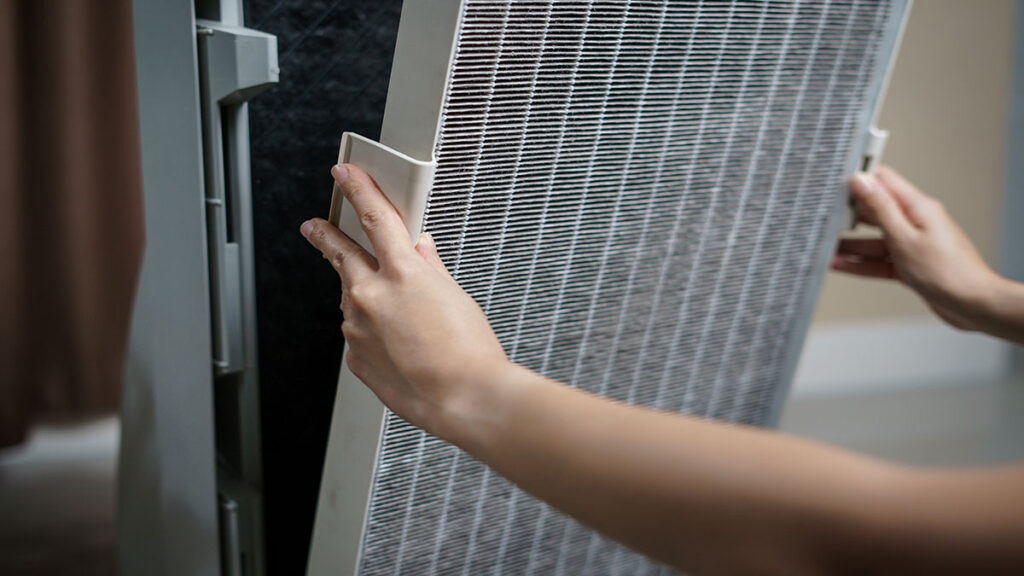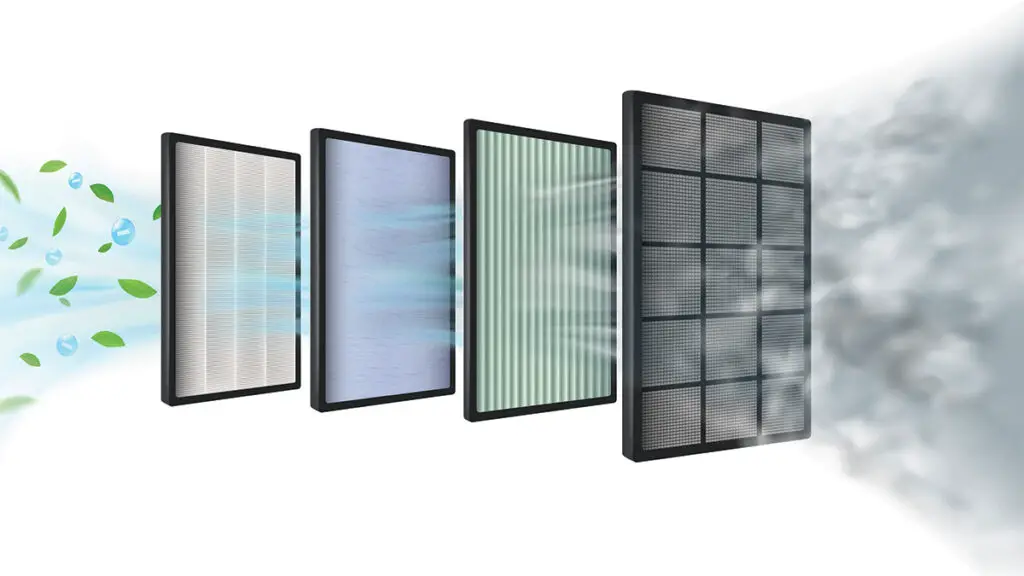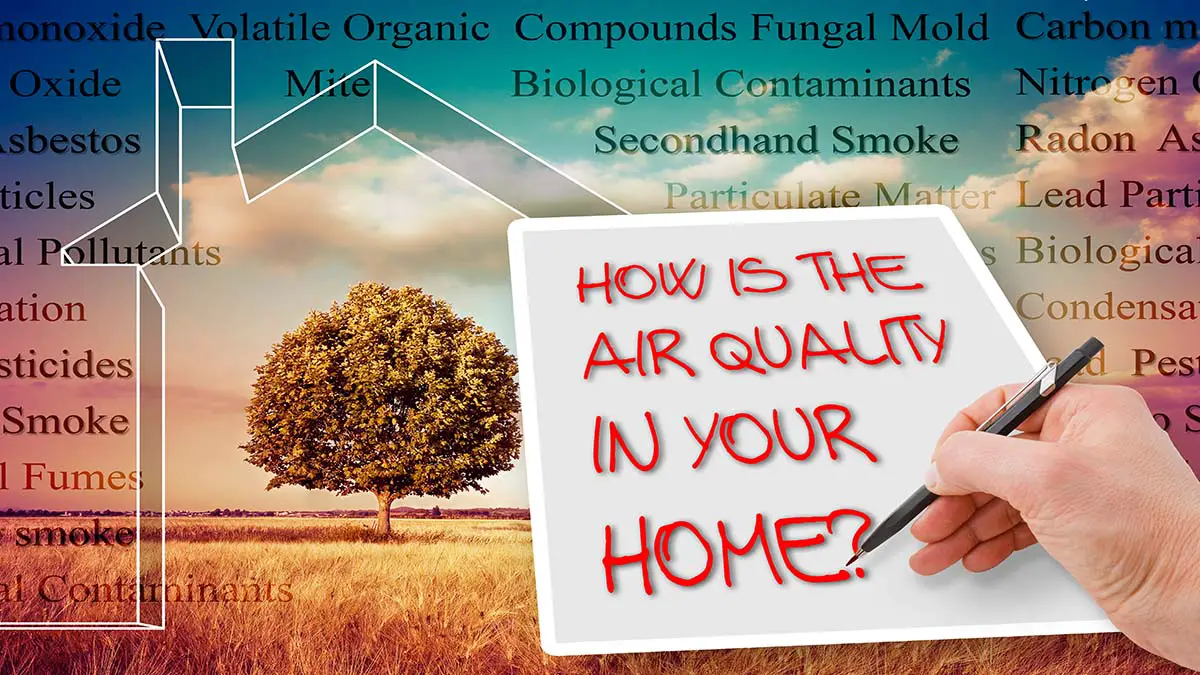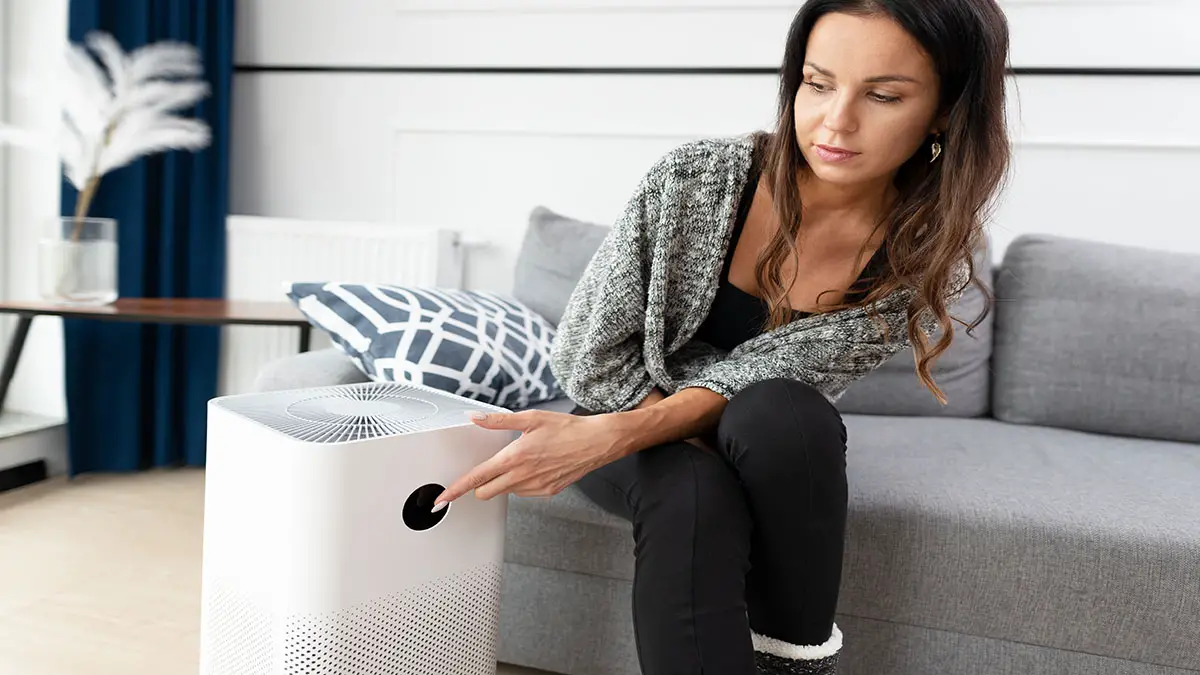If you have a HEPA air purifier in your home or office, it is essential to keep it clean to maintain its efficiency in purifying the air. Here’s our guide on how to clean a HEPA filter.
Can a HEPA filter be cleaned? HEPA filters are generally not designed to be cleaned but replaced. While some HEPA filters are marketed as “washable” or “permanent,” cleaning them can damage the delicate fibers and reduce their effectiveness.

How to Clean a HEPA Filter?
To clean a HEPA filter:
- Wash the Pre-Filter Monthly: Regularly rinse the pre-filter under running water to remove dust and larger particles. This helps maintain airflow and efficiency.
- Replace the Carbon Filter Every 6 Months: Changing the carbon filter semi-annually ensures effective removal of odors and chemical pollutants, maintaining the air purifier’s efficacy.
- Replace the HEPA Filter Annually: To ensure the best air quality, replace the HEPA filter once a year, as it traps fine particles, and its efficiency decreases with prolonged use. 2
A HEPA (High-Efficiency Particulate Air) filter is designed to trap tiny particles, such as pollen, dust mites, and pet dander, that can cause allergies or respiratory problems. Over time, these particles can accumulate in the filter, reducing effectiveness and potentially releasing them back into the air. 1
Cleaning your HEPA filter is a simple process that can be done with a few basic tools. The frequency at which you should clean your filter depends on the manufacturer’s recommendations and how often you use it.
Here are a few additional maintenance steps you should consider for maximum performance:
- Check and Clean the Exterior: Regularly wipe down the outside of the air purifier to prevent dust buildup, which can impede air intake and exhaust.
- Inspect and Clean Vents and Grills: Occasionally, check the air intake and exhaust grills for any blockages or dust accumulation. Gently clean them to ensure unobstructed airflow.
- Monitor Filter Indicators: If your air purifier has filter change indicators, pay attention to them. They can provide a more accurate indication of when filters must be replaced based on usage.
- Adjust Maintenance Based on Usage and Environment: If the air purifier is used in a particularly dusty environment or during high-pollen seasons, you may need to clean and replace the filters more frequently.
- Refer to Manufacturer’s Instructions: Always follow the manufacturer’s specific maintenance guidelines for the best care and longevity of your air purifier.
Understanding HEPA Filters
If you own an air purifier, chances are it has a HEPA filter. HEPA stands for High-Efficiency Particulate Air, and these filters are designed to capture tiny particles that other filters can’t. HEPA filters can capture particles as small as 0.3 microns, much smaller than most allergens.
HEPA filters comprise a dense fiber mat that traps particles as they pass through. These fibers are typically made of materials like fiberglass, and they are arranged in a way that maximizes surface area. This allows the filter to capture many particles without restricting airflow.
There are several different types of HEPA filters available. Some are washable or permanent, while others are designed to be replaced.
If you have a washable or permanent HEPA filter, it’s important to clean it regularly to ensure it continues functioning properly. If you have a replacement HEPA filter, you must replace it according to the manufacturer’s instructions.
In addition to the HEPA filter, many air purifiers have a pre-filter. This filter captures larger particles like dust and pet hair, which helps extend the HEPA filter’s life. Some pre-filters are washable, while others need to be replaced periodically.
Overall, HEPA filters effectively remove allergens and other particles from the air in your home. Whether you have a disposable or a washable filter, it’s important to follow the manufacturer’s instructions for cleaning and replacement to ensure that your air purifier continues functioning effectively.

Importance of Cleaning HEPA Filters
If you own an air purifier, you know how important it is to keep it clean. One of the most important parts of an air purifier is the HEPA filter.
HEPA filters are designed to remove tiny particles from the air, such as pet dander, pollen, and other allergens. These filters can become clogged with particles over time and must be cleaned or replaced.
Cleaning your HEPA filter is important for several reasons. First and foremost, it ensures that your air purifier is working at its best. A dirty HEPA filter can reduce the effectiveness of your air purifier, leading to poor air quality and potentially exacerbating allergies or other respiratory issues.
Regular cleaning of your HEPA filter can also help prolong the life of your air purifier. When a filter becomes clogged, the air flow through the purifier is reduced, which can cause the motor to work harder and wear out more quickly. Cleaning the filter can keep the air flow strong and ensure your air purifier lasts longer.
Another important reason to clean your HEPA filter is for safety. HEPA filters are designed to capture pollutants, including viruses and bacteria. If the filter becomes too dirty, it can become a breeding ground for these harmful particles, which can then be released back into the air.
Check your air purifier’s manual for specific instructions on how to clean your HEPA filter. You’ll need to remove the filter from the purifier and gently vacuum it with a soft brush attachment. Alternatively, rinse the filter with water, but let it dry completely before replacing it in the purifier.

When to Clean or Replace Your HEPA Filter
HEPA filters are known for their efficiency in capturing small particles in the air. However, they can become clogged over time, reducing their effectiveness. Knowing when to clean or replace your HEPA filter is important to ensure it continues functioning properly.
Signs that Your HEPA Filter Needs Cleaning
- Reduced airflow: If you notice that the airflow from your HEPA filter has decreased, it may be time to clean the filter. Reduced airflow can indicate that the filter is clogged with particles and needs to be cleaned.
- Visible dirt or dust: If you can see dirt or dust on the surface of your HEPA filter, it is time to clean or replace it. A dirty filter cannot capture particles effectively, reducing its overall efficiency.
- Increased noise: If your HEPA filter makes more noise than usual, it may be due to a clogged filter. When the filter is clogged, the fan must work harder to pull air through, increasing noise.
How to Clean Your HEPA Filter
HEPA filters can be cleaned by gently brushing the surface of the filter with a soft brush or by using a vacuum cleaner with a soft brush attachment. Do not wash HEPA filters with water, which can damage the filter and reduce effectiveness.
If your HEPA filter is still dirty after cleaning, it may be time to replace it. HEPA filters are not designed to be cleaned indefinitely, and replacement filters are available for purchase.
When to Replace Your HEPA Filter
HEPA filters should be replaced when they are no longer effective at capturing particles in the air. This can be determined by the Clean Air Delivery Rate (CADR) of your filter. If the CADR has decreased significantly, it may be time to replace the filter.
HEPA filters should generally be replaced every 12 to 18 months, depending on usage. If you have pets or live in a dusty environment, you may need to replace your filter more frequently.
By monitoring the signs that your HEPA filter needs cleaning or replacement, you can ensure that your filter continues to function properly and effectively captures particles in the air.
Steps to Clean a Washable Pre-Filter
Pre-filters are essential components of air purifiers and HVAC systems that help remove larger airborne particle allergens like dust and pet hair from the air.
Over time, these filters can become clogged with dirt and debris, reducing their effectiveness and performance. Cleaning a washable pre-filter is a simple process that can help extend the filter’s life and maintain efficiency.
Here are the steps to clean a washable pre-filter:
- Turn off the air purifier before removing the filter. This will prevent any dust or debris from being blown around the room.
- Remove the filter and check for any visible signs of damage or wear.
- If the filter is washable, rinse it under cold water to remove any loose dirt or debris. Be gentle to avoid damaging the pre-filter.
- Fill a sink or basin with warm water and add a small amount of mild detergent. Place the filter in the water and let it soak for a few minutes.
- Use a soft brush or sponge to gently scrub the filter, especially in areas with visible dirt or stains.
- Rinse the filter thoroughly under cold water to remove any soap residue.
- Shake off excess water and let the filter air dry completely before reinstalling it.
Note: Do not use hot water or compressed air to clean the filter, as this can damage the filter’s fibers.
Steps to Replace a Disposable Carbon or HEPA Filter
Here are the steps to replace a disposable carbon or HEPA filter:
- Be sure you have the correct replacement filter for your air purifier. Check the owner’s manual or manufacturer’s website for the specific model and filter part numbers.
- Turn off and unplug your HEPA air purifier before attempting to replace the filter. This prevents electrical accidents and keeps the unit from running without a filter.
- Locate the filter compartment on your HEPA unit. This is usually on the back or side of the unit and may require a screwdriver or other tool to open. Some have snap or magnetic clips, so be careful not to break a clip.
- Remove the old filter from the compartment and dispose of it properly. Carbon filters usually last about 6 months. HEPA filters usually last about 12 months.
- Install the new filter into the compartment, ensuring it is properly aligned and securely in place. Follow the manufacturer’s instructions for any additional steps or precautions.
- Close the filter compartment and secure it with any removed screws or latches.
- Plug in and turn on your HEPA air purifier to ensure it works properly with the new filter installed.
Maintaining Optimal Filter Performance
To ensure that your HEPA filter is performing at its best, it is important to keep it clean and well-maintained. Here are some tips to help you maintain optimal filter performance:
Regular Cleaning
Regular cleaning is essential for maintaining optimal filter performance. HEPA filters are designed to capture small particles, which can become clogged over time. When this happens, the filter’s airflow is reduced, which can decrease performance.
To clean your HEPA filter, start by removing it from the unit. Use a soft brush or vacuum cleaner to remove any loose debris from the surface of the filter. Next, wash the filter in warm, soapy water. Rinse the filter thoroughly and allow it to air dry completely before reinstalling it.
Replace Filters When Necessary
While HEPA filters are designed to last for a long time, they will eventually need to be replaced. The replacement frequency will depend on the specific filter and how often it is used. In general, it is recommended that you replace your filter every 6-12 months.
Check for Gaps
To ensure that your HEPA filter is working properly, it is important to check for gaps or leaks. Look for any gaps between the filter and the unit and any gaps in the filter itself. If you notice any gaps, seal them using tape or another appropriate material.
Increase Surface Area
To improve the performance of your HEPA filter, you can increase the surface area of the filter. This can be done by adding additional filters to the unit or using a larger filter. Increasing the filter’s surface area can help improve its airflow and CADR (Clean Air Delivery Rate).
Additional Tips and Considerations
Cleaning your HEPA filter regularly ensures it functions effectively and maintains longevity. Here are some additional tips and considerations to keep in mind when cleaning your HEPA filter:
- Use the right cleaning method: There are several methods you can use to clean your HEPA filter, including vacuuming, washing, and using compressed air. Make sure to use the right cleaning method for your specific HEPA filter. For example, washing may not be suitable for all filters, and using compressed air may damage some filters.
- Clean the pre-filter: Many HEPA filters come with a pre-filter that captures larger particles such as dust and pollen. Cleaning the pre-filter monthly can help prolong the life of your HEPA filter and improve its overall performance.
- Consider a carbon filter: If you are concerned about odors or gases, consider using a HEPA filter with a carbon filter. Activated carbon filters can help capture odors and gases like smoke, wildfires, and air pollution.
- Check for mold and allergens: HEPA filters can capture mold spores and allergens like pet dander and dust mites. Check your filter for any signs of mold or allergens, and clean it.
- Inspect the filter material: Over time, the filter material may become worn or damaged. Inspect the filter material regularly and replace it if necessary.
- Consider the surface area: HEPA filters with a larger surface area can capture more particulates and pollutants. Consider purchasing a filter with a larger surface area if you have a larger room or if your air quality is particularly poor.
- Check the canister and wheels: If your HEPA purifier comes with a canister or wheels, check them regularly for any signs of wear or damage. Replace them if necessary to ensure that your HEPA filter is functioning properly.
Frequently Asked Questions
If you have a HEPA filter, you may have some questions about how to clean it properly. Here are some frequently asked questions and answers to help you keep your filter in top shape.
Can I clean my HEPA filter with compressed air?
No, you should not clean your HEPA filter with compressed air. Compressed air can damage the delicate filter fibers and reduce their efficiency.
How do I know when it’s time to replace my HEPA filter?
HEPA filters should be replaced when they are no longer effective at trapping airborne particles or when they become visibly dirty or damaged. It is recommended to replace a HEPA filter every 6 to 12 months based on the manufacturer’s guidelines.
Can HEPA filters be vacuumed and reused?
Vacuuming a HEPA filter can damage the filter’s fibers and decrease efficiency. HEPA filters are designed for single use and should be replaced regularly to maintain air quality.
How do you clean a HEPA filter with vinegar?
Cleaning a HEPA filter with vinegar or any liquid is not advisable. Introducing liquids can disrupt the filter’s material and compromise its ability to trap particles effectively.
Can you put a HEPA filter in a washing machine?
HEPA filters should not be placed in a washing machine. The agitation and water can damage the filter’s structure, rendering it less effective or unusable.
Can you wash the pre-filter in a dishwasher?
The intense heat and strong detergents used in dishwashers can damage the delicate materials of the pre-filter. Instead, most pre-filters can be gently cleaned with a vacuum or rinsed with lukewarm water by hand, depending on the manufacturer’s instructions.
- National Library of Medicine: What can individuals do to reduce personal health risks from air pollution?
- Bergman W. Maximum HEPA-filter Life. Lawrence Livermore National Laboratory, Livermore, California. 1999 Jun.








